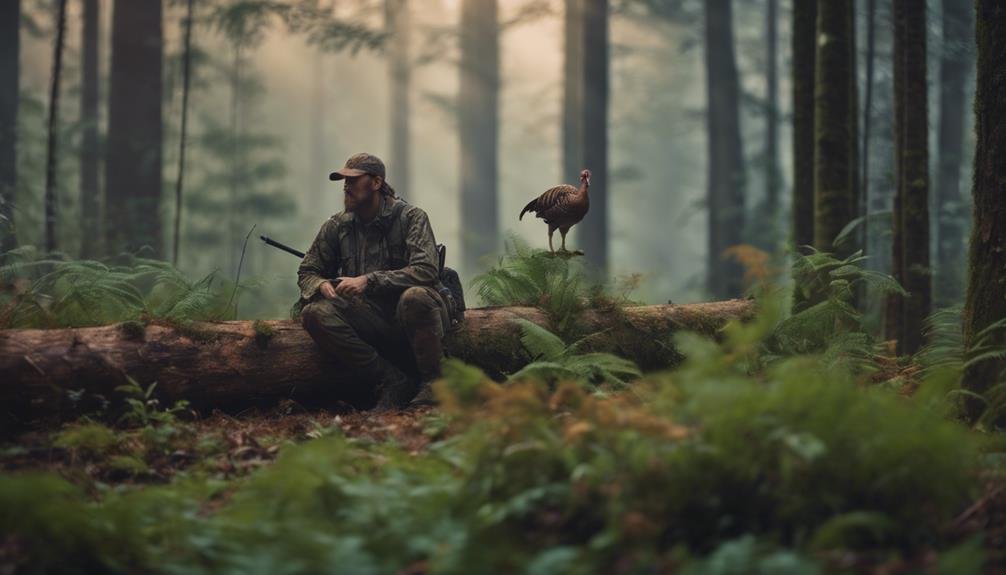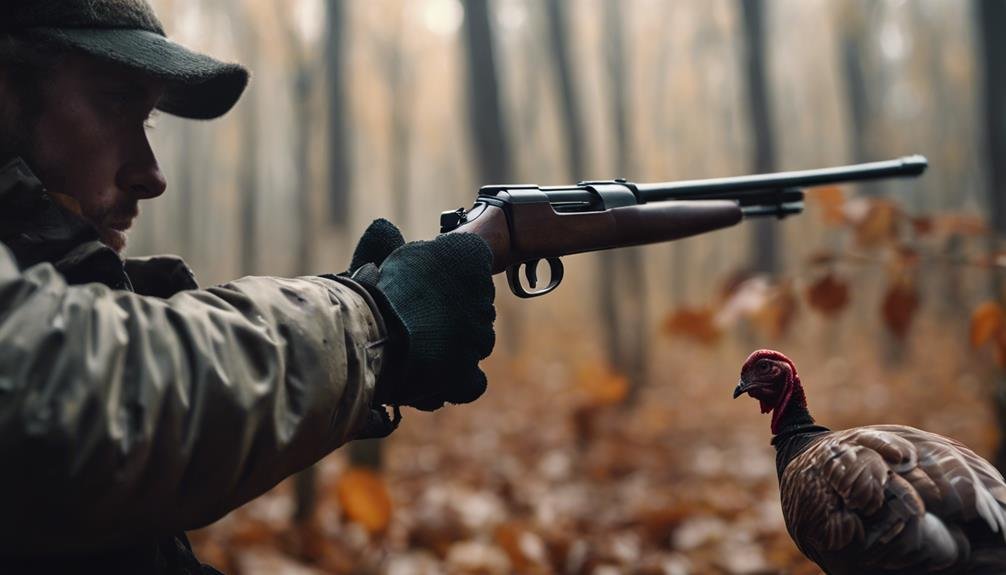In the heart of the dense, primeval forest, turkey hunting is a test of endurance, strategy, and skill, where the hunter's ability to adapt, navigate, and connect with the wilderness is paramount to success. Big woods hunting demands a unique mental preparation and hunting philosophy, requiring patience, adaptability, and resilience. Hunters must understand the terrain and its rhythms to succeed, locating turkeys in the deep by identifying roost trees and food sources. As you venture deeper into the woods, the stakes are raised, and only the most skilled and prepared hunters will emerge victorious, but the reward is worth the challenge – and the journey has only just begun.
Key Takeaways
- Adopt a patient, adaptable, and resilient mindset to overcome obstacles and unpredictability in big woods turkey hunting.
- Identify roost trees with large branches, dense canopies, and proximity to water sources and minimal human disturbance.
- Master silent stalking and timber tactics to increase chances of bagging an elusive gobbler in the deep woods.
- Recognize turkey patterns and habits by deciphering vocalizations, identifying daily routines, and understanding preferred habitats and food sources.
- Cultivate woodland awareness, staying alert and focused to detect subtle signs of turkey activity and increase odds of success.
Understanding Big Woods Hunting
As you step into the vast, shadowy expanse of big woods, the silence is palpable, punctuated only by the rustle of leaves and snapping of twigs beneath your feet, a reminder that in this environment, turkey hunting is as much a test of endurance as it is a game of strategy and skill. To succeed, hunters must adopt a unique mental preparation and hunting philosophy. To succeed, hunters must adopt a mindset that is crucial to acknowledge that big woods turkey hunting is a challenging and unpredictable endeavor, requiring a deep understanding of the terrain and its rhythms. By embracing this reality, hunters can cultivate a mindset that is patient, adaptable, and resilient – qualities that are vital for overcoming the obstacles that big woods hunting presents.
Locating Turkeys in the Deep
In the depths of the big woods, where the canopy is so dense it filters out most of the sunlight, the search for turkeys begins with a deliberate and patient approach, one that requires a deep understanding of the terrain and its rhythms. To increase success rates, locating turkeys on the roost during the first morning and evening of the hunt is essential.
| Roost Tree Identification | Timber Turkey Behavior |
|---|---|
| Look for trees with large, sturdy branches | Turkeys prefer trees with dense canopies |
| Scan for signs of turkey activity, such as droppings | Turkeys often roost near water sources |
| Identify trees with food sources, like acorns or berries | Turkeys tend to roost in areas with minimal human disturbance
Mobility and Stealth in Timber
When the search for turkeys on the roost yields a promising lead, the next step is to strategically position yourself for a stealthy approach, one that demands a mobile and nimble hunter capable of threading the dense timber undetected. This is where silent stalking and timber tactics come into play. A hunter must be prepared to adapt to the ever-changing environment, using the terrain to their advantage. By mastering the art of silent stalking, you can slip undetected into the heart of the timber, where the wary toms reside. It's a delicate dance, one that requires patience, persistence, and a deep understanding of the forest's rhythms. By embracing mobility and stealth, you'll increase your chances of bagging that elusive gobbler.
Finding Food in the Wilderness
Picking up on the subtle signs of turkey activity, such as scattered leaves, scratched earth, or faint tracks, often leads hunters to the hidden gems of the wilderness: food sources that attract and sustain turkeys. As we venture deeper into the forest, the forest floor comes alive with the rustling of leaves and snapping of twigs, hinting at the presence of these elusive birds. Wilderness feeding areas, such as low-lying wetlands or timber edges, become magnets for turkeys seeking sustenance. By identifying these hotspots, hunters can increase their chances of encountering their quarry. By understanding the turkey's feeding habits, we can anticipate their movements and set up ambushes in areas where they're most likely to congregate.
Mastering Turkey Patterns and Habit
How do you decipher the subtle language of turkey behavior, where a slight change in routine can make all the difference between a successful hunt and a fruitless foray into the woods? Mastering turkey patterns and habit requires a deep understanding of their behavior, movements, and vocalizations. To successfully interpret turkey behavior, you must recognize the nuances of turkey talk, from the soft clucks and purrs to the loud gobbles and yelps. By paying attention to these patterns, you can anticipate their movements and set up ambushes in likely hotspots.
- Turkey Talk: Learn to recognize the different vocalizations and their meanings.
- Pattern Recognition: Identify the daily routines and habits of the turkeys.
- Habitat Knowledge: Understand the preferred habitats and food sources of the turkeys.
- Adaptability: Be prepared to adjust your strategy based on the turkeys' changing patterns.
Staying Alert in the Timber
In the dimly lit, cathedral-like expanse of big woods, where towering trees stretch towards the sky and shadows dance across the forest floor, a hunter's senses must remain perpetually heightened to detect the subtle signs of turkey activity. To stay alert in the timber, adopt a forest mindset, where every snap of a twig or rustle of leaves is a potential clue. Employ timber tactics like silent stalking, moving deliberately and deliberately, to increase your chances of encountering a wary tom. Maintain an alert posture, scanning your surroundings with a keen eye, and cultivate woodland awareness, tuning into the subtle rhythms of the forest. By staying alert and focused, you'll increase your odds of success in the big woods.
Calling and Concealment Strategies
As you navigate the dense, shadowy landscape of big woods turkey hunting, the art of calling and concealment becomes a critical component of your strategy, one that can mean the difference between a successful harvest and a day spent wandering through the silence. When it comes to concealment, a well-placed Tree Stand or Ground Blind can be a game-changer, allowing you to get up close and personal with your quarry. To further enhance your setup, consider incorporating Soft Calls and Face Paint to blend seamlessly into the surroundings.
- Master the soft, subtle calls that mimic the gentle clucks and purrs of a hen turkey.
- Use Face Paint to blend in with the dappled sunlight filtering through the trees.
- Select a Tree Stand or Ground Blind that allows for maximum concealment and minimal movement.
- Practice your calling and concealment strategies in low-light conditions to simulate real-world hunting scenarios.
Adapting to the Big Woods Environment
Through the dense canopy of big woods, where sunlight filters in dappled patterns and ancient trees loom like sentinels, adapting to the environment becomes a delicate dance between hunter and habitat. To thrive in this unforgiving landscape, turkey hunters must cultivate mental toughness, pushing through the frustration of scarce sign and limited visibility. Physical conditioning is also essential, as the rugged terrain and endless miles of hiking test even the most seasoned hunters. By embracing the challenges of the big woods, hunters can develop the resilience and agility needed to outmaneuver their quarry. As the hunt unfolds, adaptability becomes the key to success, as hunters must adjust to shifting weather patterns, ephemeral bird movements, and the ever-present uncertainty of the wild.
Frequently Asked Questions
How Do I Deal With Hunting Pressure in Popular Big Woods Areas?
To mitigate hunting pressure in popular big woods areas, employ versatile hunting strategies, adapting to forest dynamics, and focus on isolated, unpressured birds, increasing success rates through mobility, stealth, and an intimate understanding of turkey behavior and habitat nuances.
What Is the Best Time of Day to Hunt Turkeys in Deep Woods?
As the morning sun peeks through the canopy, woodland patterns come alive, and turkeys begin their morning movement, making the early dawn hours, just after fly-down, the prime time to hunt, when birds are most active and vocal.
Can I Use Decoys Effectively in Dense, Wooded Areas?
In dense woodland settings, strategically placing decoys in small clearings or along game trails can be effective, especially when paired with woodland camo and careful Decoy Placement, increasing the likelihood of luring in wary toms.
How Do I Navigate Safely in Dense Woods With Limited Visibility?
When trekking dense woods with limited visibility, prioritize map reading skills to identify landmarks and trails, and employ flashlight strategies like using red light modes to preserve night vision, ensuring a safe and successful journey.
What Are Some Essential Items to Include in My Big Woods Turkey Hunting Pack?
Did you know that a turkey hunter's success rate increases by 30% when they're prepared with the right gear? When packing for big woods turkey hunting, prioritize essential items like a reliable calls, extra batteries, and a first-aid kit, and organize your pack by categorizing gear into 'must-haves' and 'nice-to-haves' to guarantee a successful hunt.
Conclusion
In the depths of the big woods, where turkey hunters often find themselves entangled in a labyrinth of uncertainty, success is not a guarantee, but rather a fleeting whisper of opportunity. It is in these unforgiving domains that the refined skills of adaptability, persistence, and strategic thinking are put to the ultimate test. Yet, it is precisely this brutal landscape that beckons the most resilient and resourceful hunters, who, like ghosts, vanish into the timber, driven by an unyielding pursuit of the elusive wild turkey.









